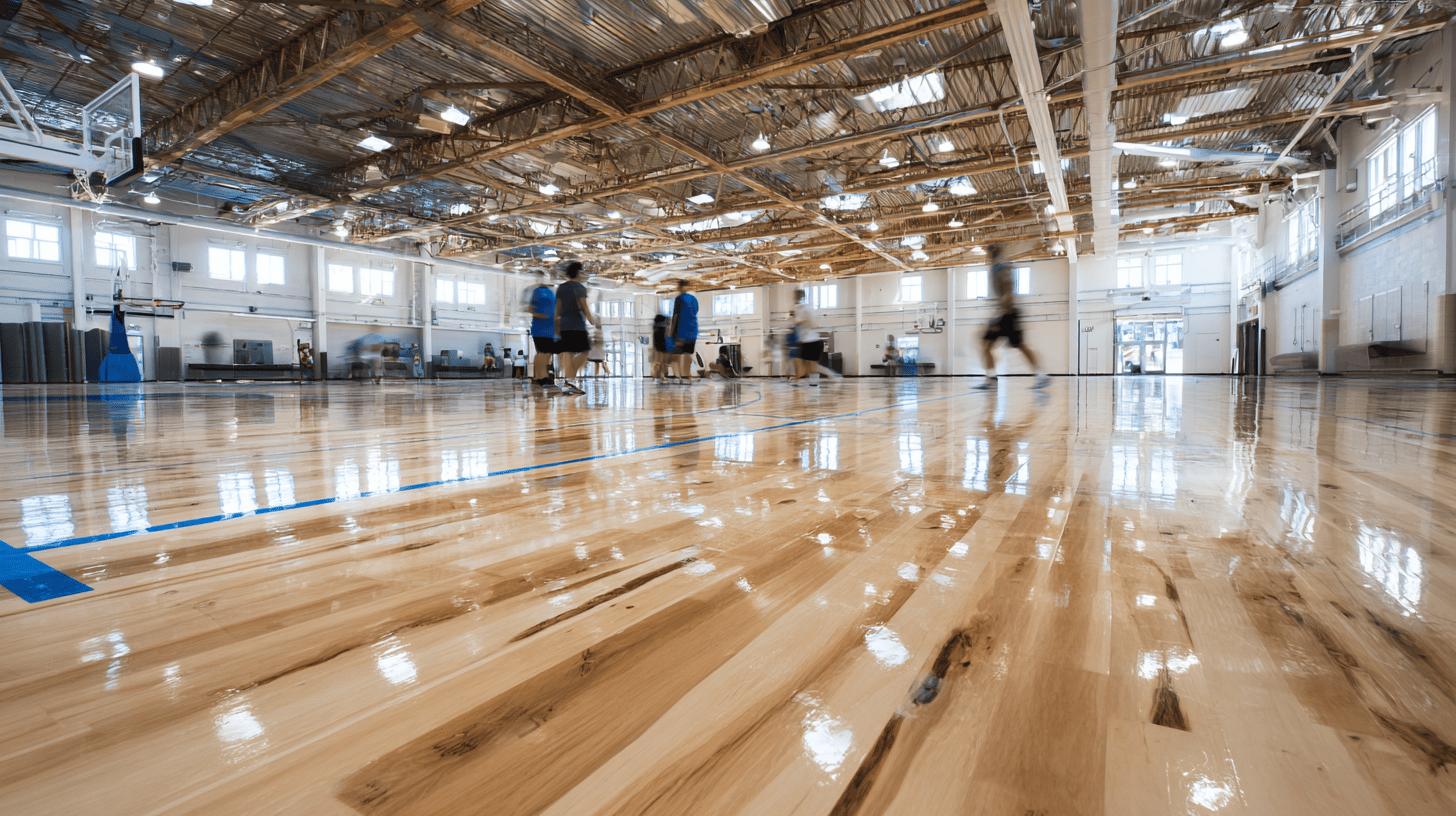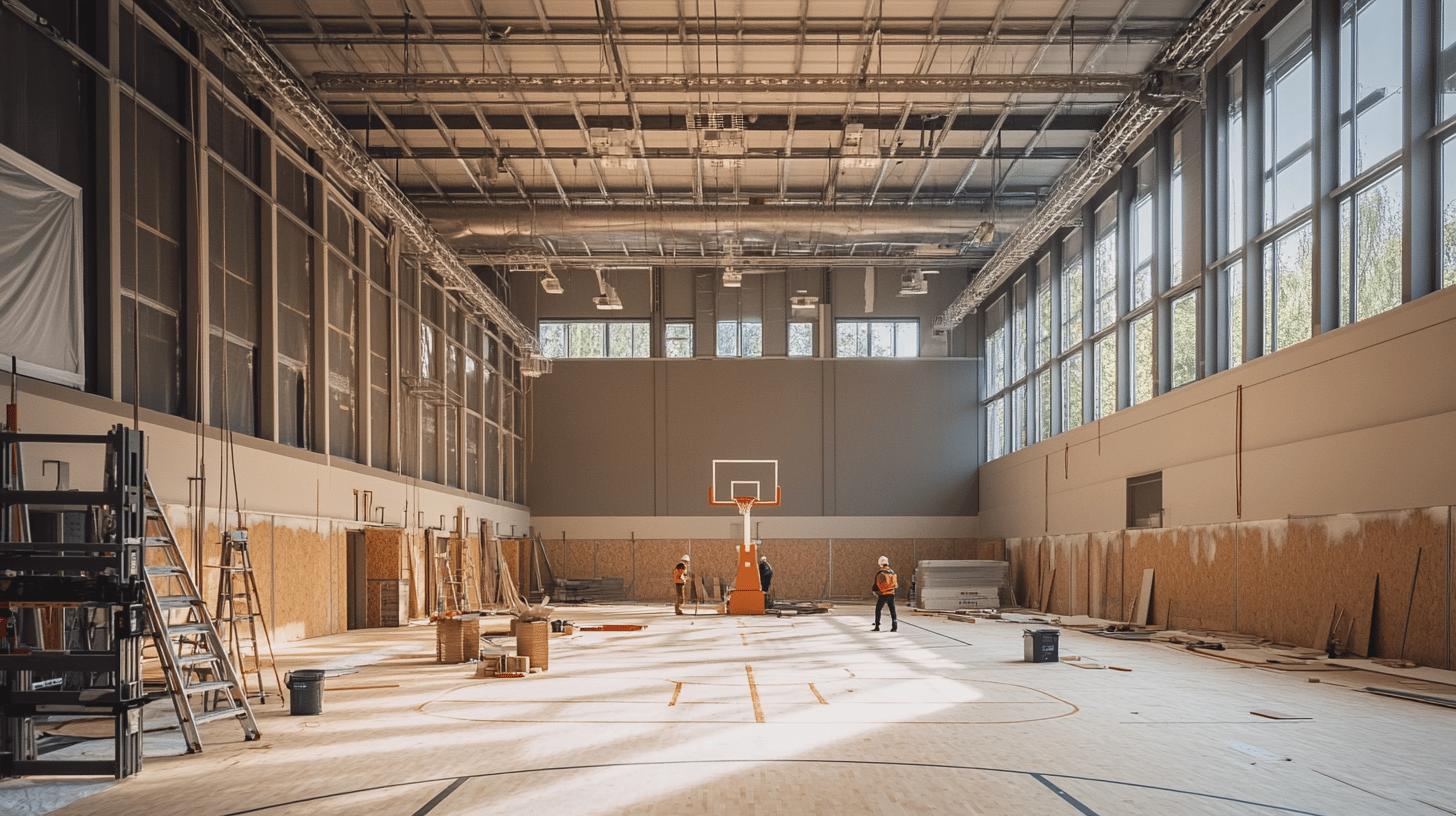Transform your standard vinyl sports hall into a state-of-the-art sprung timber arena—could it revolutionise your facility’s performance and appeal? The process of hard-court conversion is intricate, from meticulously stripping the old vinyl to engineering a resilient timber floor on a sprung support structure. This guide will navigate you through each technical aspect and provide professional insights, ensuring a seamless transition. By embracing this change, sports facilities can enhance athlete safety, performance, and compliance with industry standards, paving the way for a superior sporting environment.
Step-by-Step Guide to Hard-Court Conversion from Vinyl to Sprung Timber
The process of converting vinyl floors to a sprung timber sports arena begins with the meticulous removal of the existing vinyl flooring. Precision is key here to prevent damage to the subfloor and ensure a smooth transition. This task involves cutting the vinyl into manageable sections, carefully lifting it, and disposing of it in accordance with environmental regulations. It’s crucial to inspect the condition of the subfloor post-removal to identify any damage or irregularities that need addressing before proceeding. For optimal results, engaging professionals with experience in sports hall refurbishment is recommended, as they possess the necessary skills and equipment to execute this task efficiently.
Once the vinyl is removed, attention shifts to preparing the subfloor, a critical phase that impacts the longevity and performance of the new flooring system. The subfloor must be thoroughly cleaned, levelled, and assessed for structural integrity. Levelling is essential, as uneven surfaces can lead to performance issues and safety hazards. Structural assessments identify areas needing repair or reinforcement, ensuring the subfloor can adequately support the new timber system. This preparation stage may also include moisture testing to prevent future issues with timber warping or adhesive failures. Proper subfloor preparation is vital to provide a stable foundation for the sprung timber installation.
The final step involves installing the sprung timber floor, which includes placing a timber deck on a specialised sprung support system. This system enhances the floor’s elasticity, offering superior shock absorption and increasing athlete comfort and performance. Installation requires precise alignment and secure fixing of the timber boards to the support system, ensuring a seamless and durable surface. Using high-quality engineered sports boards is advisable for their improved elasticity and longevity. It is essential to follow manufacturer guidelines and comply with relevant sports flooring standards to achieve the best results. A professional installation team can ensure the correct implementation of the sprung system, maximising the benefits of the new timber floor.
- Cut and remove vinyl flooring carefully.
- Inspect and repair the subfloor as needed.
- Clean and level the subfloor thoroughly.
- Conduct moisture testing to ensure stability.
- Install the timber deck on a sprung support system.
.
Material Requirements and Costs for Converting a Vinyl Hall
For a successful conversion from vinyl to a sprung timber arena, selecting the appropriate materials is paramount. Engineered hardwood is the preferred choice for the surface due to its enhanced elasticity and durability compared to solid timber. This type of hardwood, combined with a robust sub-construction system, forms the foundation of the new flooring. The sub-construction typically includes a sprung support system, which is essential for providing the necessary shock absorption and resilience. Additionally, moisture barriers, adhesive, and finishing products are crucial components to ensure a seamless and long-lasting installation. Opting for high-quality materials not only improves performance but also extends the floor’s lifespan, making it a wise investment for multi-purpose sports facilities.
Cost estimation for converting a vinyl hall to a timber arena involves several key factors. The cost of materials, such as engineered sports boards and sub-construction systems, forms the primary expense. Labour costs can vary significantly depending on the complexity of the installation and the expertise of the professionals involved. Additional features like underfloor heating can enhance athlete comfort but will increase overall costs. Acoustic treatments may also be necessary, especially if the venue hosts a variety of activities, to ensure optimal sound quality. Safety enhancements, such as line markings and slip-resistant coatings, should be incorporated into the budget to comply with sports standards and regulations.
Benefits of Sprung Timber Floors over Vinyl

Sprung timber floors significantly improve shock absorbency compared to vinyl, reducing the risk of injuries and enhancing athlete safety. This is achieved through their unique construction, which includes both a resilient surface and a shock-absorbing sub-construction. As a result, athletes benefit from a surface that minimises impact forces, offering greater protection against stress-related injuries. This makes sprung timber floors an ideal choice for sports halls prioritising athlete safety and performance.
The elasticity provided by sprung timber floors enhances both performance and comfort. Unlike vinyl, which offers a rigid surface, timber courts allow for natural movement and energy return, aiding in athletic performance. This elasticity is beneficial for sports that require agility and speed, as it allows athletes to move more freely and efficiently. Moreover, the comfort provided by a sprung surface reduces fatigue, enabling longer and more intense training sessions.
Sprung timber floors adhere to stringent safety standards, such as EN 14904, ensuring they meet performance and quality benchmarks recognised by sports governing bodies. Their compliance with these standards not only guarantees safety but also confirms their durability and long-term value. These floors are designed to withstand the demands of high-traffic sports environments, providing a reliable surface that retains its quality over time. Thus, investing in sprung timber flooring is an investment in both safety and longevity.
Challenges and Considerations in Vinyl to Timber Conversion
When converting a vinyl hall into a sprung timber arena, compliance with updated sports standards is a significant challenge. Ensuring the floor meets guidelines, such as those set by the Education and Skills Funding Agency (ESFA), is crucial for both safety and functionality. The transition from synthetic to timber requires careful planning to accommodate the specific needs of various sports and activities. Each sport may have distinct requirements for shock absorption, traction, and surface resilience, necessitating a tailored approach to floor design and installation. Addressing these compliance challenges ensures the new timber floor supports a wide range of athletic pursuits while aligning with industry regulations.
Acoustic considerations and environmental adaptations are also vital during the conversion process. Timber floors can significantly alter the sound dynamics within a sports arena, potentially impacting both players and spectators. Implementing acoustic treatments, such as wall padding or ceiling baffles, can mitigate sound issues and create a more conducive environment for events. Additionally, the natural properties of timber require adaptation to local climate conditions to prevent warping or expansion. Maintaining optimal humidity and temperature levels within the hall is essential to preserve the integrity and performance of the timber floor over time.
Managing Installation Challenges
To ensure a smooth installation process, it’s essential to manage the transition period effectively. This includes scheduling the conversion to minimise disruption, coordinating with stakeholders, and securing experienced professionals for the task. A phased installation approach can help accommodate ongoing activities, while thorough communication ensures all parties are informed of timelines and expectations. By addressing potential hurdles proactively, the conversion can proceed efficiently, resulting in a high-quality, functional sports arena that meets all intended requirements.
Case Studies and Professional Insights on Hard-Court Conversion
Bradford Academy offers an exemplary case study of converting a vinyl sports hall into a sprung timber arena. By collaborating with Junckers, a renowned manufacturer of sports and dance floor systems, the academy transformed its facility to enhance athletic performance and safety. Junckers introduced a state-of-the-art vinyl sports floor featuring a sprung undercarriage system, which successfully balanced durability with the shock absorption benefits typical of solid wood flooring. The project underscored the importance of selecting a partner with proven expertise in sports flooring solutions, ensuring both compliance with safety standards and the delivery of a versatile sports environment.
Professional insights from flooring specialists stress the significance of thorough planning and material selection in conversion projects. Experts recommend engaging with experienced contractors who can assess the existing structure and recommend suitable materials, such as engineered sports boards, for their elasticity and longevity. Additionally, specialists highlight the need to consider acoustics and environmental factors, ensuring the new flooring meets all performance standards and offers a comfortable, functional space for multiple sports activities.
- Collaborate with experienced manufacturers for tailored solutions.
- Prioritise material selection for elasticity and durability.
- Address acoustics and environmental factors for optimal performance.
.
Final Words
Transitioning from a vinyl hall to a sprung timber sports arena is an intricate yet rewarding process. The journey begins with vinyl removal, followed by meticulous subfloor preparation, culminating in the installation of a sprung timber floor. Material selection, including engineered hardwood and a robust support system, is pivotal for a successful conversion. Key advantages of sprung timber floors, such as enhanced shock absorbency and compliance with safety standards, offer immense benefits over vinyl. Challenges around guidelines and acoustic considerations are manageable with professional assistance. Ultimately, a well-executed hard-court conversion transforms sports facilities into superior arenas for athletes.
Comparing Different Sports Flooring Materials: Find Your Match
Start a conversion → Wooden Sports Flooring
FAQ
What is the process for converting a vinyl floor to a sprung timber sports court?
Converting a vinyl floor involves removing the existing vinyl, preparing the subfloor, and installing a timber deck with a sprung support system. It is essential to use high-quality materials and conduct a thorough assessment of the existing structure.
What materials are required for converting a vinyl hall to a timber sports court?
Materials needed include engineered hardwood for the surface and a sub-construction support system. Using engineered sports boards is recommended due to their elasticity and durability.
How much does it cost to convert a vinyl hall to a timber sports court?
Costs include materials, labour, and additional features like underfloor heating. Professional insights highlight the importance of considering total expenses, including acoustic or safety enhancements.
What are the benefits of sprung timber floors over vinyl?
Sprung timber floors offer superior shock absorbency, reducing injury risk. They enhance performance and comfort with their elastic properties and comply with safety standards like EN 14904, ensuring long-term durability.
What challenges may arise when converting from vinyl to timber sports flooring?
Challenges include ensuring compliance with updated guidelines and transitioning from synthetic to timber. Acoustic and environmental considerations are crucial for maintaining a suitable indoor climate and sound levels.
How can installation challenges be managed during the conversion process?
Effective management strategies include planning for the transition period, addressing potential issues early, and ensuring a seamless installation to meet all intended sports and activity requirements.
Are there any real-world examples or insights for hard-court conversion?
Bradford Academy collaborated with Junckers for sports hall flooring replacement. Case studies reveal valuable insights and highlight potential pitfalls, underscoring the importance of professional consultations.
- Consult with manufacturers like Junckers.
- Anticipate potential compliance challenges.
- Consider professional insights for longevity.


